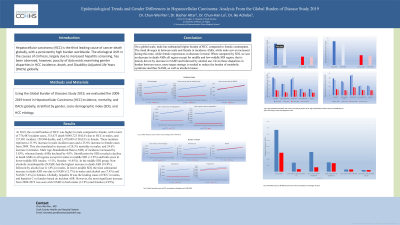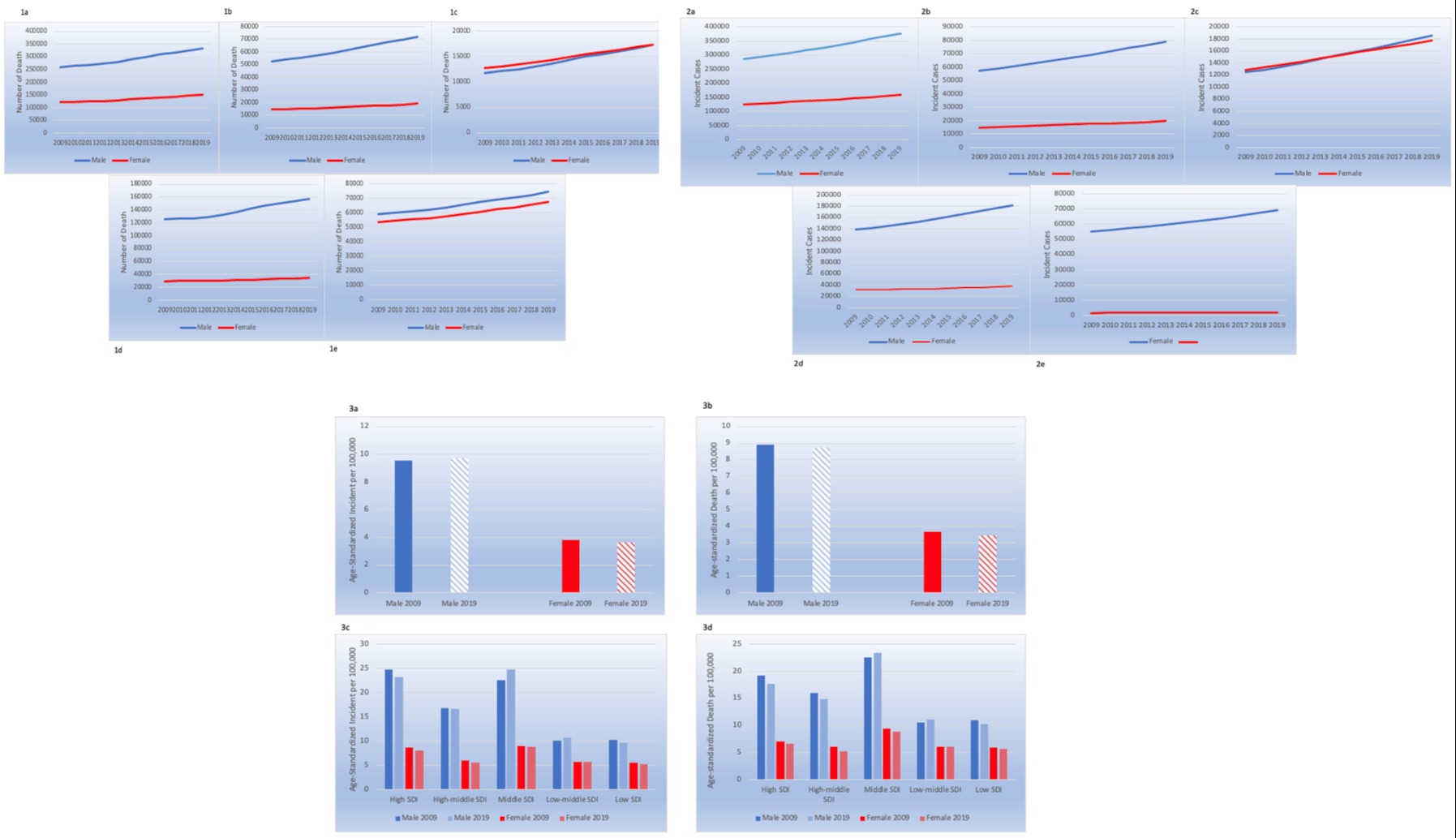Tuesday Poster Session
Category: Liver
P3770 - Epidemiological Trends and Gender Differences in Hepatocellular Carcinoma: Analysis From the Global Burden of Disease Study 2019
Tuesday, October 24, 2023
10:30 AM - 4:00 PM PT
Location: Exhibit Hall

- CP
Chun-Wei Pan, MD
John H. Stroger, Jr. Hospital of Cook County
Chicago, IL
Presenting Author(s)
Chun-Wei Pan, MD1, Bashar Attar, MD2, Chun-Han Lo, MD, MPH3, Ike Achebe, MD4
1John H. Stroger, Jr. Hospital of Cook County, Chicago, IL; 2Cook County Health, Chicago, IL; 3Kirk Kerkorian School of Medicine at UNLV, Las Vegas, NV; 4University of Massachusetts Chan Medical School, Worcester, MA
Introduction: Hepatocellular carcinoma (HCC) is the third leading cause of cancer death globally, with a persistently high burden worldwide. The etiological shift in the causes of cirrhosis, largely due to increased hepatitis screening, has been observed, however, paucity of data exists examining gender disparities in HCC incidence, death, and Disability-Adjusted Life Years (DALYs) globally.
Methods: Using the Global Burden of Diseases Study 2019, we evaluated the 2009-2019 trend in Hepatocellular Carcinoma (HCC) incidence, mortality, and DALYs globally, stratified by gender, socio-demographic index (SDI), and HCC etiology.
Results: In 2019, the overall burden of HCC was higher in male compared to female, with a total of 376,483 incident cases, 333,673 death 9,048,723 DALYs due to HCC in males, and 157,881 incident, 150,904 deaths, and 3,479,699 of DALYs in female. These numbers represent a 31.9% increase in male incident cases and a 25.8% increase in female cases from 2009. This also translated to increase of 28.3% mortality in males, and 24.6% increase in females. Male Age-Standardized Rates (ASR) of incidence increased by 3.85%, whereas female ASRs declined by 4.0%. Stratification by SDI revealed a decline in death ASRs in all regions except for males in middle SDI (+3.9%) and both sexes in lower-middle SDI (males: +5.5%, females: +0.45%). In the middle SDI group, Non-alcoholic steatohepatitis (NASH) had the highest increase in death ASR (18.8%), followed by alcohol use (11.8%) in males. In lower-middle SDI, the most substantial increase in death ASR was due to NASH (12.7%) in males and alcohol use (7.4%) and NASH (7.4%) in females. Globally, hepatitis B was the leading cause of HCC in males, and hepatitis C in females based on incident ASR. However, the most significant increase from 2009-2019 was seen with NASH in both males (12.9%) and females (4.95%).
Discussion: On a global scale, male has higher burden of HCC compared to female counterparts. The trend diverges in between male and female in incidence ASRs, while male saw an increased during this time, while female experiences in decrease in trend. When compared by SDI, we saw an decrease in death ASRs all region except for middle and low-middle SDI region, that is mainly driven by increase in NASH and followed by alcohol use. Given these disparities in burden between sexes, more target strategy is needed to reduce the burden of metabolic syndrome and thus NASH, as well as alcohol misuse.

Disclosures:
Chun-Wei Pan, MD1, Bashar Attar, MD2, Chun-Han Lo, MD, MPH3, Ike Achebe, MD4. P3770 - Epidemiological Trends and Gender Differences in Hepatocellular Carcinoma: Analysis From the Global Burden of Disease Study 2019, ACG 2023 Annual Scientific Meeting Abstracts. Vancouver, BC, Canada: American College of Gastroenterology.
1John H. Stroger, Jr. Hospital of Cook County, Chicago, IL; 2Cook County Health, Chicago, IL; 3Kirk Kerkorian School of Medicine at UNLV, Las Vegas, NV; 4University of Massachusetts Chan Medical School, Worcester, MA
Introduction: Hepatocellular carcinoma (HCC) is the third leading cause of cancer death globally, with a persistently high burden worldwide. The etiological shift in the causes of cirrhosis, largely due to increased hepatitis screening, has been observed, however, paucity of data exists examining gender disparities in HCC incidence, death, and Disability-Adjusted Life Years (DALYs) globally.
Methods: Using the Global Burden of Diseases Study 2019, we evaluated the 2009-2019 trend in Hepatocellular Carcinoma (HCC) incidence, mortality, and DALYs globally, stratified by gender, socio-demographic index (SDI), and HCC etiology.
Results: In 2019, the overall burden of HCC was higher in male compared to female, with a total of 376,483 incident cases, 333,673 death 9,048,723 DALYs due to HCC in males, and 157,881 incident, 150,904 deaths, and 3,479,699 of DALYs in female. These numbers represent a 31.9% increase in male incident cases and a 25.8% increase in female cases from 2009. This also translated to increase of 28.3% mortality in males, and 24.6% increase in females. Male Age-Standardized Rates (ASR) of incidence increased by 3.85%, whereas female ASRs declined by 4.0%. Stratification by SDI revealed a decline in death ASRs in all regions except for males in middle SDI (+3.9%) and both sexes in lower-middle SDI (males: +5.5%, females: +0.45%). In the middle SDI group, Non-alcoholic steatohepatitis (NASH) had the highest increase in death ASR (18.8%), followed by alcohol use (11.8%) in males. In lower-middle SDI, the most substantial increase in death ASR was due to NASH (12.7%) in males and alcohol use (7.4%) and NASH (7.4%) in females. Globally, hepatitis B was the leading cause of HCC in males, and hepatitis C in females based on incident ASR. However, the most significant increase from 2009-2019 was seen with NASH in both males (12.9%) and females (4.95%).
Discussion: On a global scale, male has higher burden of HCC compared to female counterparts. The trend diverges in between male and female in incidence ASRs, while male saw an increased during this time, while female experiences in decrease in trend. When compared by SDI, we saw an decrease in death ASRs all region except for middle and low-middle SDI region, that is mainly driven by increase in NASH and followed by alcohol use. Given these disparities in burden between sexes, more target strategy is needed to reduce the burden of metabolic syndrome and thus NASH, as well as alcohol misuse.

Figure: 1)Number of Death 1a) All etiologies 1b) Alcohol Use 1c) NASH 1d)Hepatitis B 1e) Hepatitis C 2)Number of Incident cases 2a) All etiologies 2b) Alcohol use 2c)NASH 2d)Hepatitis B 2e) Hepatitis C 3a)ASR Incident per 100,000 3b) ASR Death per 100,000 3c) ASR incident Rate by SDI region 3d) ASR Death by SDI region
Disclosures:
Chun-Wei Pan indicated no relevant financial relationships.
Bashar Attar indicated no relevant financial relationships.
Chun-Han Lo indicated no relevant financial relationships.
Ike Achebe indicated no relevant financial relationships.
Chun-Wei Pan, MD1, Bashar Attar, MD2, Chun-Han Lo, MD, MPH3, Ike Achebe, MD4. P3770 - Epidemiological Trends and Gender Differences in Hepatocellular Carcinoma: Analysis From the Global Burden of Disease Study 2019, ACG 2023 Annual Scientific Meeting Abstracts. Vancouver, BC, Canada: American College of Gastroenterology.
